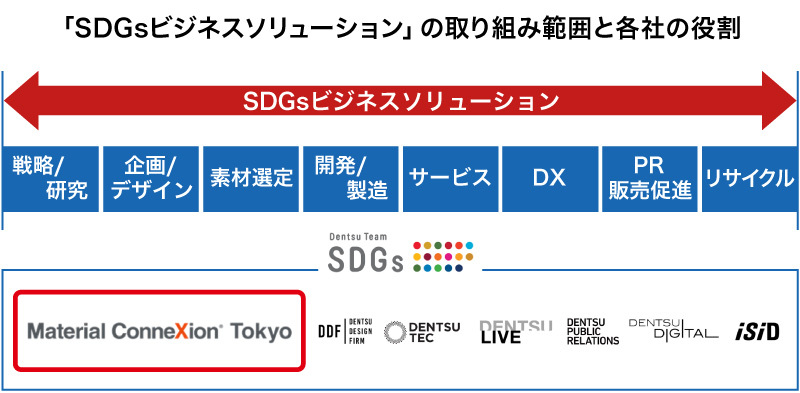Note: This website was automatically translated, so some terms or nuances may not be completely accurate.
Eliminating containers altogether is one approach. Considering sustainable material choices.

Kumiko Yoshikawa
M Crossing Co., Ltd.
Seven companies, led by Dentsu Group, have collaborated to launch the "SDGs Business Solution" ( press release here ) to support corporate efforts in building a circular economy.

This time, we introduce the work of Material ConneXion Tokyo (hereafter, Material ConneXion Tokyo), a participant in the SDGs Business Solution. Material ConneXion is a "group of material experts" that operates material libraries in seven locations worldwide and provides material-focused consulting.
We spoke with Kumiko Yoshikawa, CEO of M-Crossing, which operates Material ConneXion Tokyo, about the importance of material selection in building a circular economy.

Material Connection is a "group of material specialists" holding over 8,000 materials.
──First, could you tell us about Material Connection Tokyo's business activities?
Yoshikawa: Founded in New York in 1997, Material Connection operates seven global hubs, supporting innovation in design, product development, and manufacturing centered around materials. Material Connection Tokyo was established in 2013 as the Japanese hub.
Our business consists of three main areas. First is managing our library, built through researching materials worldwide. We offer both an online database and physical libraries at each location where materials can be touched. The database holds over 8,000 materials, with 20 to 30 new items added monthly. Second is consulting, proposing optimal materials to companies and designers. Third is supporting connections between material manufacturers and companies.

The materials we handle are diverse, serving product development professionals across various industries including automotive, home appliances, architecture, interior design, sports, and fashion. Material selection often lacks opportunities to explore materials outside one's own industry. Material Connection uniquely enables encounters with materials used in other sectors. A key strength is its role as a "space for idea generation"—inspiration from previously unknown materials can lead to creating new value.
What are the challenges in selecting materials from a sustainable perspective?
──It has been six years since the SDGs were adopted by the UN. How do you view the current state of "material selection from a sustainable perspective"?
Yoshikawa: One challenge in advancing sustainable manufacturing is the limited selection of materials. While there are relatively more options overseas, domestically, there are still few materials readily available for immediate use and mass production.
Furthermore, when considering the entire lifecycle from consumer use to disposal, significant regional differences exist in infrastructure aspects like whether disposal methods are properly established or if recycling is feasible. This must also be understood. Global companies, in particular, must select materials considering the infrastructure conditions of the countries and regions where their products circulate, as their distribution areas are vast. Therefore, I feel the current reality is that it's difficult to replace the materials currently in use.
Additionally, I sense varying levels of understanding about "SDGs," "sustainability," and the "circular economy" across different corporate departments. It's necessary to deepen understanding company-wide before establishing concrete policies.
──Specifically, how should materials be selected?
Yoshikawa: Taking material selection for "plastic reduction" as an example, one approach is to switch to "non-petroleum-based plastics." Plant-based plastics are well-known. However, even within plant-based plastics, the materials vary widely. While plastics can be made from crops like corn, as global warming progresses, the amount of land available for agriculture worldwide is expected to decrease. Consequently, there is a growing consensus that using farmland for plastic feedstocks should be avoided as much as possible. Therefore, plastics made from cellulose fibers derived from plants like wood, or plastics produced through microbial processes—methods that "do not compete with crops"—are gaining attention and undergoing active development.
Another approach involves switching to "materials other than plastic." For example, wood-derived materials that can be injection molded like plastic are gaining attention as they do not produce microplastics that contribute to ocean pollution. Choosing existing materials like aluminum or paper is another approach. Aluminum, in particular, has a very high recycling rate for beverage cans in Japan—90%—and recycling it requires only 3% of the energy needed to produce aluminum from scratch. Switching to materials with established recycling infrastructure is thus an effective strategy.
* A plastic molding method where resin is melted, injected into a mold, and solidified to form the shape.
One recent plastic-free example I found interesting is a shampoo developed by a venture company that resembles solid soap. This eliminates the need for both plastic bottles and refill containers. Changing the product itself like this is another idea for reducing plastic.
Even just focusing on plastic reduction, there are various options. We hope to work with companies within our "SDGs Business Solutions" framework to find the optimal approach. Furthermore, if corporate initiatives accelerate, demand for materials will increase, potentially lowering prices. Visualizing this demand should also encourage more companies to explore material development. We aim to contribute to innovation in material development.
I also strongly feel that the concept of the circular economy needs to be better understood and more widely adopted. Shifting to this mindset should naturally create a path for selecting the optimal materials, taking into account the end-of-life of products.
The key to material selection lies in balancing performance and sustainability.
──I imagine Material Connection's library is also used by many overseas companies. Are material selections made with an SDGs perspective happening overseas as well?
Yoshikawa: Overseas, selecting materials that achieve sustainability is becoming standard practice. While our library gathers materials from around the world, we used to see many materials that emphasized using discarded items, like "leather made from apple peels." Recently, however, I feel there are increasing numbers of materials where sustainability is a given, and their functionality and performance are equal to or better than conventional materials. Consumers in the US and Europe tend to be more sensitive to these issues compared to Japan, and a certain number of people are willing to purchase sustainable products even if they cost more.
Of course, in Japan too, using materials that combine "high performance" with "sustainability" is ideal. However, aiming for that from the outset is quite challenging. Replacing materials while maintaining the existing product specifications requires considerable effort. Moreover, compared to overseas markets, I believe products in Japan are expected to meet significantly higher specifications. Therefore, going forward, it will be important to review areas where adjustments are possible and to communicate effectively with consumers to gain their acceptance.
For example, if switching to plastic-free packaging shortens a food product's shelf life, it would be beneficial to slightly lower the product price to compensate. Rather than simply stating "We switched to sustainable packaging," we should solve the challenges arising from material changes through innovation—encompassing the product's form, mechanisms, and monetization—while also providing customers with new experiential value. We expect our "SDGs Business Solutions" initiative with the Dentsu Group to make this possible.
Supporting the "manufacturing" aspect and proposing concrete solutions for implementation
──What role does Material Connection Tokyo play within the "SDGs Business Solutions"?
Yoshikawa: The "SDGs Business Solutions" initiative supports companies in building circular economies, not only through advertising and communication but also by providing manufacturing support. Within this, we aim to offer concrete support as "material specialists" to realize sustainable manufacturing.
In the circular economy concept, where products are designed from the planning stage to prevent waste, material selection is crucial. That's precisely why many companies struggle with this. For such companies, we want to provide not only material proposals but also support regarding processing technologies—such as "how to process" and "where to process"—when they actually engage in manufacturing.
──Mr. Yoshikawa, what do you see as the strengths of the Dentsu Group in this collaboration?
Yoshikawa: Having worked in advertising and communications for many years, I value the extensive network of diverse stakeholders we've built.
We often work with people involved in design, development, and manufacturing. However, we feel it's extremely difficult for these individuals alone to achieve sustainable manufacturing. Even with a clear vision, challenges like "Is this aligned with company policy?" or "How do we persuade internal stakeholders to make the decision?" pile up, making smooth progress difficult.
However, our "SDGs Business Solutions" initiative bridges the gap between company executives with decision-making authority and the business units responsible for production. This enables projects to progress with a unified vision from upstream to downstream. This is precisely what the Dentsu Group, with its strength in communications, can deliver. Having people from various roles within the company work together as one team should also lead to the creation of better solutions. We want to work together to figure out the "next move" when translating the vision of building a circular economy into concrete business initiatives.
Was this article helpful?
Newsletter registration is here
We select and publish important news every day
For inquiries about this article
Back Numbers
Author

Kumiko Yoshikawa
M Crossing Co., Ltd.
President and CEO
At parent company NISSHA, I belonged to the division handling products that simultaneously transfer patterns during resin molding. I established a department that proposed designs utilizing our proprietary technology to the design departments of home appliance and automotive manufacturers. In 2013, I was involved in establishing Material Connection Tokyo, and in April 2015, I became Representative Director of its operating company, M-Crossing. I provide material consulting that drives innovation by cross-border utilization of materials and processing technologies across diverse fields.



